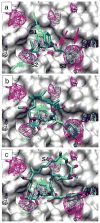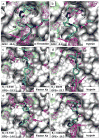Reproducing crystal binding modes of ligand functional groups using Site-Identification by Ligand Competitive Saturation (SILCS) simulations
- PMID: 21456594
- PMCID: PMC3090225
- DOI: 10.1021/ci100462t
Reproducing crystal binding modes of ligand functional groups using Site-Identification by Ligand Competitive Saturation (SILCS) simulations
Abstract
The applicability of a computational method, Site Identification by Ligand Competitive Saturation (SILCS), to identify regions on a protein surface with which different types of functional groups on low-molecular weight inhibitors interact is demonstrated. The method involves molecular dynamics (MD) simulations of a protein in an aqueous solution of chemically diverse small molecules from which probability distributions of fragments types, termed FragMaps, are obtained. In the present application, SILCS simulations are performed with an aqueous solution of 1 M benzene and propane to map the affinity pattern of the protein for aromatic and aliphatic functional groups. In addition, water hydrogen and oxygen atoms serve as probes for hydrogen-bond donor and acceptor affinity, respectively. The method is tested using a set of 7 proteins for which crystal structures of complexes with several high affinity inhibitors are known. Good agreement is obtained between FragMaps and the positions of chemically similar functional groups in inhibitors as observed in the X-ray crystallographic structures. Quantitative capabilities of the SILCS approach are demonstrated by converting FragMaps to free energies, termed Grid Free Energies (GFE), and showing correlation between the GFE values and experimental binding affinities. For proteins for which ligand decoy sets are available, GFE values are shown to typically score the crystal conformation and conformations similar to it more favorable than decoys. Additionally, SILCS is tested for its ability to capture the subtle differences in ligand affinity across homologous proteins, information which may be of utility toward specificity-guided drug design. Taken together, our results show that SILCS can recapitulate the known location of functional groups of bound inhibitors for a number of proteins, suggesting that the method may be of utility for rational drug design.
Figures












Similar articles
-
Inclusion of multiple fragment types in the site identification by ligand competitive saturation (SILCS) approach.J Chem Inf Model. 2013 Dec 23;53(12):3384-98. doi: 10.1021/ci4005628. Epub 2013 Nov 25. J Chem Inf Model. 2013. PMID: 24245913 Free PMC article.
-
Computational fragment-based binding site identification by ligand competitive saturation.PLoS Comput Biol. 2009 Jul;5(7):e1000435. doi: 10.1371/journal.pcbi.1000435. Epub 2009 Jul 10. PLoS Comput Biol. 2009. PMID: 19593374 Free PMC article.
-
Site Identification by Ligand Competitive Saturation (SILCS) simulations for fragment-based drug design.Methods Mol Biol. 2015;1289:75-87. doi: 10.1007/978-1-4939-2486-8_7. Methods Mol Biol. 2015. PMID: 25709034 Free PMC article.
-
The significance of the 20-carbonyl group of progesterone in steroid receptor binding: a molecular dynamics and structure-based ligand design study.Steroids. 2003 Nov;68(10-13):869-78. doi: 10.1016/j.steroids.2003.08.009. Steroids. 2003. PMID: 14667979 Review.
-
Development, validation, and applications of anisotropic polarizable molecular mechanics to study ligand and drug-receptor interactions.Curr Pharm Des. 2006;12(17):2121-58. doi: 10.2174/138161206777585256. Curr Pharm Des. 2006. PMID: 16796560 Review.
Cited by
-
Binding hotspots on K-ras: consensus ligand binding sites and other reactive regions from probe-based molecular dynamics analysis.Proteins. 2015 May;83(5):898-909. doi: 10.1002/prot.24786. Epub 2015 Mar 25. Proteins. 2015. PMID: 25740554 Free PMC article.
-
Driving Structure-Based Drug Discovery through Cosolvent Molecular Dynamics.J Med Chem. 2016 Dec 8;59(23):10383-10399. doi: 10.1021/acs.jmedchem.6b00399. Epub 2016 Aug 17. J Med Chem. 2016. PMID: 27486927 Free PMC article. Review.
-
Rationally Designed Polypharmacology: α-Helix Mimetics as Dual Inhibitors of the Oncoproteins Mcl-1 and HDM2.ChemMedChem. 2020 Sep 16;15(18):1691-1698. doi: 10.1002/cmdc.202000278. Epub 2020 Jun 25. ChemMedChem. 2020. PMID: 32583936 Free PMC article.
-
Acyl-2-aminobenzimidazoles: a novel class of neuroprotective agents targeting mGluR5.Bioorg Med Chem. 2015 May 1;23(9):2211-20. doi: 10.1016/j.bmc.2015.02.054. Epub 2015 Mar 6. Bioorg Med Chem. 2015. PMID: 25801156 Free PMC article.
-
Accelerating fragment-based drug discovery using grand canonical nonequilibrium candidate Monte Carlo.Nat Commun. 2025 Jul 4;16(1):6198. doi: 10.1038/s41467-025-60561-3. Nat Commun. 2025. PMID: 40615366 Free PMC article.
References
-
- Jorgensen WL. The many roles of computation in drug discovery. Science. 2004;303:1813–1818. - PubMed
-
- Congreve M, Chessari G, Tisi D, Woodhead AJ. Recent developments in fragment-based drug discovery. J Med Chem. 2008;51:3661–3680. - PubMed
-
- Kollman PA. Free energy calculations: Applications to chemical and biochemical phenomena. Chem Rev. 1993;93:2395–2417.
-
- Erlanson DA, McDowell RS, O’Brien T. Fragment-based drug discovery. J Med Chem. 2004;47:3463–3482. - PubMed
Publication types
MeSH terms
Substances
Grants and funding
LinkOut - more resources
Full Text Sources
Other Literature Sources

